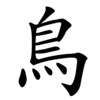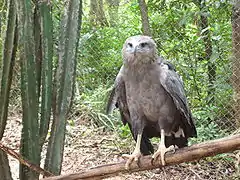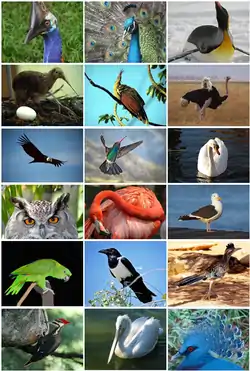鳥
| ||||||||
| ||||||||
Translingual
| Stroke order | |||
|---|---|---|---|
 | |||
Han character
鳥 (Kangxi radical 196, 鳥+0, 11 strokes, cangjie input 竹日卜火 (HAYF), four-corner 27327, composition ⿴烏一)
- Kangxi radical #196, ⿃.
Derived characters
References
- KangXi: page 1480, character 52
- Dai Kanwa Jiten: character 46634
- Dae Jaweon: page 2012, character 25
- Hanyu Da Zidian (first edition): volume 7, page 4613, character 1
- Unihan data for U+9CE5
Chinese
| trad. | 鳥 | |
|---|---|---|
| simp. | 鸟 | |

Glyph origin
| Historical forms of the character 鳥 | ||
|---|---|---|
| Shang | Western Zhou | Shuowen Jiezi (compiled in Han) |
| Oracle bone script | Bronze inscriptions | Small seal script |
 |
 |
 |
Pictogram (象形) : a bird with a dangling tail.
Compare 烏, which is very similar, of similar origin, and 隹, which originated from a similar image of a bird, but is today rather more abstract and less recognizable. Compare to Egyptian 𓄿
Etymology
Originally pronounced with a /t-/ initial (compare 島 (OC *tuːwʔ, “island”)). In many dialects, it changed to a /n-/ initial to avoid homophony with the vulgar word 屌 (diǎo, “penis”), which may ultimately have developed from the sense “bird”. Birds/fowl are characteristically associated with Chinese slang for genitalia; compare 雀 (“sparrow > penis”) and 雞 (“chicken > penis”).
Alternatively, Schuessler (2007) hypothesised that the /n-/ initial form for “bird” may be unrelated to the /t-/ form. Instead, it may be connected with the Tai-Kadai word for bird; compare Proto-Tai *C̬.nokᴰ (“bird”), whence Thai นก (nók).
The /t-/ form may be derived from Proto-Sino-Tibetan *daw (“bird”), cognate with Proto-Karen *thoᴮ (“bird”) and Proto-Bodo-Garo *tao² (“bird”).
Pronunciation 1
Definitions
鳥
Synonyms
Compounds
|
|
|
Descendants
- → Thai: เจี๊ยว (jíao)
Pronunciation 2
Definitions
鳥
Japanese
Readings
Compounds
- 鳥瞰 (chōkan)
- 鳥瞰図 (chōkanzu)
- 鳥獣 (chōjū)
- 鳥葬 (chōsō)
- 鳥類 (chōrui, “bird, birds; avian”)
- 愛鳥 (aichō, “beloved bird; love for birds”)
- 益鳥 (ekichō, “beneficial bird”)
- 害鳥 (gaichō, “harmful bird”)
- 伽藍鳥 (karanchō, “pelican”)
- 七面鳥 (shichimenchō, “turkey”)
- 慈鳥 (jichō, “crow, raven”)
- 人鳥 (jinchō, “penguin”)
- 駝鳥 (dachō, “ostrich”)
- 火の鳥 (hi no tori, “phoenix”, in Western mythology)
- 不死鳥 (fushichō, “undying bird”)
- 雷鳥 (raichō, “ptarmigan, a snow grouse”)
- 雷神鳥 (raijinchō, “thunderbird”)
Etymology 1
| Kanji in this term |
|---|
| 鳥 |
| とり Grade: 2 |
| kun’yomi |
⟨to2ri⟩ → /tori/
From Old Japanese, from Proto-Japonic *təri. Probably cognate with Middle Korean ᄃᆞᆰ (tolk), modern Korean 닭 (dak, “fowl; chicken”).
May also be related to the Japanese verb 飛ぶ (tobu, “to fly”).
Noun
鳥 • (tori)
- a bird
- 1999 July 5, “タクヒ [Takuhi]”, in BOOSTER 3, Konami:
- このトリが現れた時は、何か不吉な事が起こる前ぶれ。
- Kono tori ga arawareta toki wa, nani ka fukitsu na koto ga okoru maebure.
- This bird brings bad luck to wherever it comes.
- このトリが現れた時は、何か不吉な事が起こる前ぶれ。
- 1999 August 26, “セイント・バード [Saint Bird]”, in BOOSTER 4, Konami:
- 非常に尾の長い鳥。全身から聖なる光を発する。
- Hijō ni o no nagai tori. Zenshin kara seinaru hikari o hassuru.
- A bird with an unusually long tail. It illuminates with holy light.
- 非常に尾の長い鳥。全身から聖なる光を発する。
-
- a chicken
- 1086, Goshūi Wakashū (book 16, poem 939; also Hyakunin Isshu, poem 62)
- fowl or chicken meat
Derived terms
- 酉 (Tori): the Cock in the Chinese zodiac
- 鳥居 (torī, “torii gate”, literally "bird stand, bird perch")
- 鳥インフルエンザ (tori infuruenza, “avian influenza, bird flu”)
- 鳥籠 (torikago, “birdcage”)
- 鳥刺し (torisashi, “chicken sashimi, raw chicken meat”)
- 信天翁 (ahōdori, “albatross”)
- 臼辺鳥 (usubedori): chicken (bird)
- 鴛鴦 (oshidori, “mandarin duck”)
- 鶏 (niwatori, “chicken”)
Etymology 2
| Kanji in this term |
|---|
| 鳥 |
| と Grade: 2 |
| kun’yomi |
⟨to2ri⟩ → ⟨*to2⟩ → /to/
From Old Japanese.[4][5] Appears to be a shift from tori above.
Pronunciation
- IPA(key): [to̞]
- The pitch accent is determined by the entire word.
Usage notes
Appears in old compounds. Does not appear to be productive in modern Japanese.
Derived terms
References
- 1998, NHK日本語発音アクセント辞典 (NHK Japanese Pronunciation Accent Dictionary) (in Japanese), Tōkyō: NHK, →ISBN
- 2006, 大辞林 (Daijirin), Third Edition (in Japanese), Tōkyō: Sanseidō, →ISBN
- Steven D. Carter (1991) Traditional Japanese Poetry: An Anthology, illustrated edition, Stanford University Press, →ISBN, page 225
- 1988, 国語大辞典(新装版) (Kokugo Dai Jiten, Revised Edition) (in Japanese), Tōkyō: Shogakukan
- 1995, 大辞泉 (Daijisen) (in Japanese), Tōkyō: Shogakukan, →ISBN
Korean
Etymology
From Middle Chinese 鳥 (MC teuX).
| Historical Readings | ||
|---|---|---|
| Dongguk Jeongun Reading | ||
| Dongguk Jeongun, 1448 | 됴ᇢ〯 (Yale: tyǒw) | |
| Middle Korean | ||
| Text | Eumhun | |
| Gloss (hun) | Reading | |
| Hunmong Jahoe, 1527 | 새〯 (Yale: sǎy) | 됴〮 (Yale: tyó) |
Pronunciation
- (SK Standard/Seoul) IPA(key): [t͡ɕo̞]
- Phonetic hangul: [조]
Okinawan
Pronunciation
- IPA(key): [tui]
References
- “とぅい【鳥】” in JLect - Japonic Languages and Dialects Database Dictionary, 2019.
